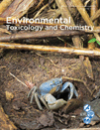The effect of pH on chronic aquatic Ni toxicity is dependent on the pH itself: extending the chronic Ni bioavailability models
 The chronic toxicity of Ni is strongly dependent on the physico-chemistry (pH, Ca, Mg, Dissolved Organic Carbon) of freshwater environments. Metal bioavailability models predict metal toxicity in receiving waters by taking into account the effects of pH and the formation of (in)organic ligand on metal bioavailability and the effects of cations, such as Ca & Mg, on metal uptake. Currently, the Environmental Quality Standard (EQS) for Ni in the Water Framework Directive (WFD) is bioavailability based. Although some of the available chronic Ni bioavailability models are only validated for pH up to 8.2, a considerable fraction of the European surface waters has a pH above 8.2. Therefore, we investigated the effect of a change in pH from 8.2 to 8.7 on chronic Ni toxicity to 3 invertebrate (Daphnia magna, Lymnaea stagnalis, and Brachionus calyciflorus) and 2 plant species (Pseudokirchneriella subcapitata and Lemna minor). Next, we investigated whether existing chronic Ni bioavailability models could be used to predict chronic Ni toxicity above pH 8.2.
The chronic toxicity of Ni is strongly dependent on the physico-chemistry (pH, Ca, Mg, Dissolved Organic Carbon) of freshwater environments. Metal bioavailability models predict metal toxicity in receiving waters by taking into account the effects of pH and the formation of (in)organic ligand on metal bioavailability and the effects of cations, such as Ca & Mg, on metal uptake. Currently, the Environmental Quality Standard (EQS) for Ni in the Water Framework Directive (WFD) is bioavailability based. Although some of the available chronic Ni bioavailability models are only validated for pH up to 8.2, a considerable fraction of the European surface waters has a pH above 8.2. Therefore, we investigated the effect of a change in pH from 8.2 to 8.7 on chronic Ni toxicity to 3 invertebrate (Daphnia magna, Lymnaea stagnalis, and Brachionus calyciflorus) and 2 plant species (Pseudokirchneriella subcapitata and Lemna minor). Next, we investigated whether existing chronic Ni bioavailability models could be used to predict chronic Ni toxicity above pH 8.2.
We observed that Ni toxicity was almost always significantly higher at pH 8.7 than at pH 8.2. Chronic Ni toxicity above pH 8.2 was consistently underestimated using the existing chronic Ni bioavailability models. The results suggest that the effect of pH on Ni2+ toxicity is dependent on the pH itself: the slope of the pH effect is steeper above than below pH 8.2 for species for which a species-specific bioavailability model exists. Therefore, the existing chronic Ni bioavailability models were modified to allow predictions of chronic Ni toxicity to invertebrates and plants in the 8.2-8.7 pH range, by applying a pH slope (SpH) which is dependent on the pH of the target water. These modified Ni bioavailability models resulted in more accurate predictions of Ni toxicity to all 5 species (i.e., within 2-fold error), without the bias observed using the bioavailability models developed for pH up to 8.2.
The results of this study can decrease the uncertainty in implementing the bioavailability based EQS under the WFD for high pH regions in Europe. All chronic Ni bioavailability models were integrated in a ‘chronic Ni bioavailability and normalization tool’, which can be used to calculate bioavailability based HC5s in target waters with pH from 6.5 to 8.7.
Scientific abstracts
The Environmental Quality Standard (EQS) for Ni in the Water Framework Directive (WFD) is bioavailability based. Although some of the available chronic Ni bioavailability models are only validated for pH≤8.2, a considerable fraction of the European surface waters has a pH > 8.2. Therefore, we investigated the effect of a change in pH from 8.2 to 8.7 on chronic Ni toxicity to 3 invertebrate (Daphnia magna, Lymnaea stagnalis, and Brachionus calyciflorus) and 2 plant species (Pseudokirchneriella subcapitata and Lemna minor). Ni toxicity was almost always significantly higher at pH 8.7 than at pH 8.2. To test whether the existing chronic Ni bioavailability models developed for pH≤8.2, can be used at higher pH levels, Ni toxicity at pH 8.7 was predicted based on Ni toxicity observed at pH 8.2. This resulted in a consistent underestimation of toxicity. The results suggest that the effect of pH on Ni2+ toxicity is dependent on the pH itself: the slope of the pH effect is steeper above than below pH 8.2 for species for which a species-specific bioavailability model exists. Therefore, the existing chronic Ni bioavailability models were modified to allow predictions of chronic Ni toxicity to invertebrates and plants in the 8.2–8.7 pH range, by applying a pH slope (SpH) which is dependent on the pH of the target water. These modified Ni bioavailability models resulted in more accurate predictions of Ni toxicity to all 5 species (i.e., within 2-fold error), without the bias observed using the bioavailability models developed for pH≤8.2. The results of this study can decrease the uncertainty in implementing the bioavailability based EQS under the WFD for high pH regions in Europe.
Full reference (link)
Nys C, Janssen CR, Van Sprang P, De Schamphelaere KAC. The effect of pH on chronic aquatic Ni toxicity is dependent on the pH itself: extending the chronic Ni bioavailability models. Environmental Toxicology and Chemistry (Accepted article)
